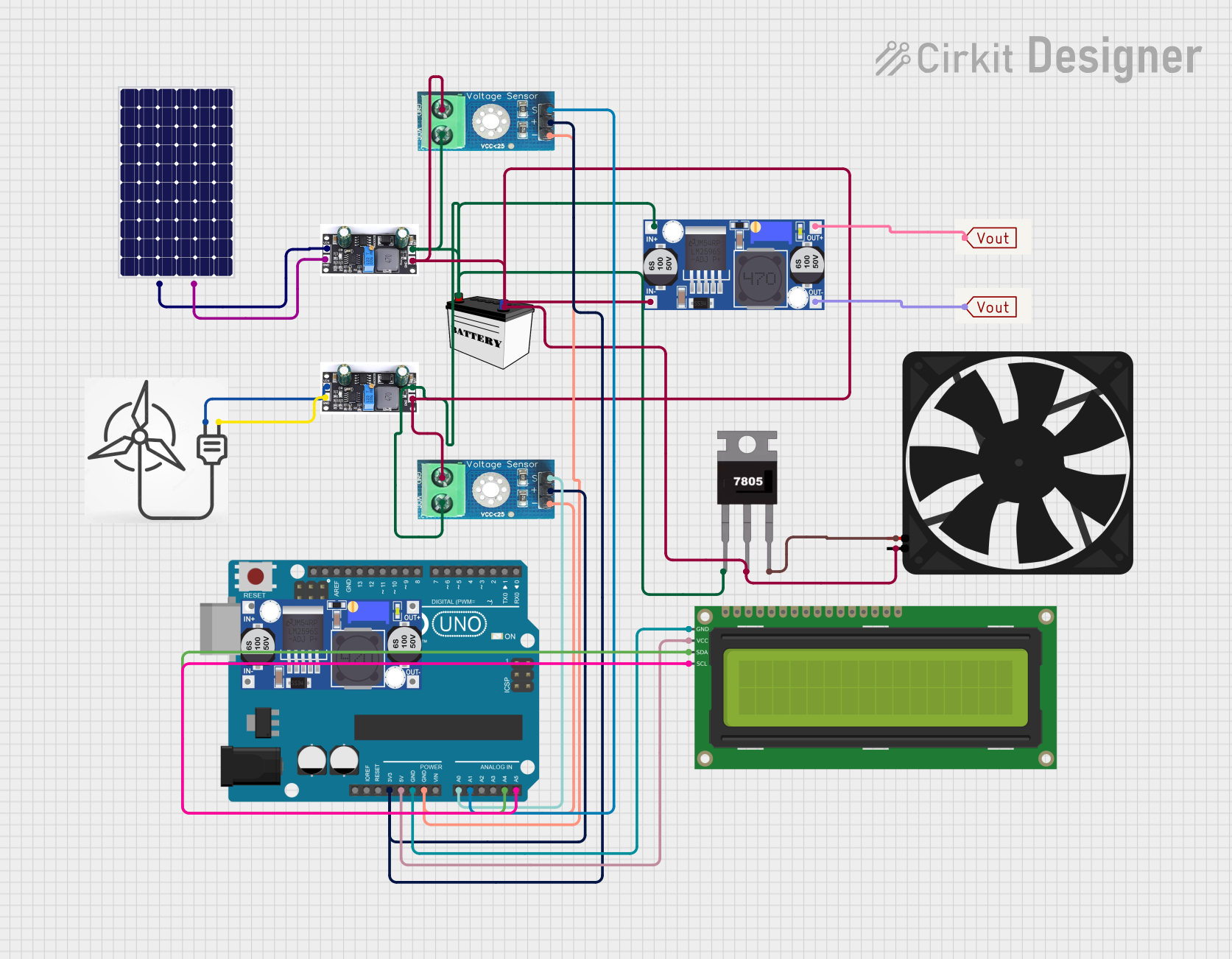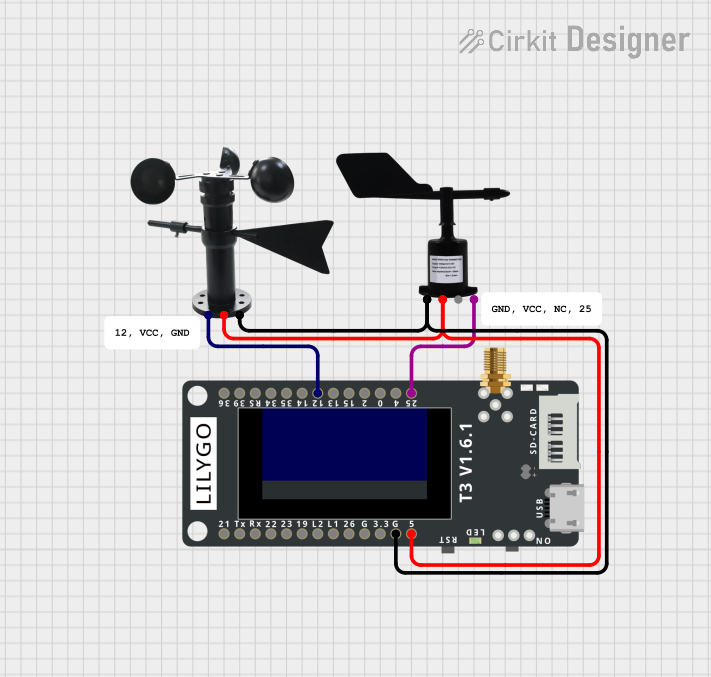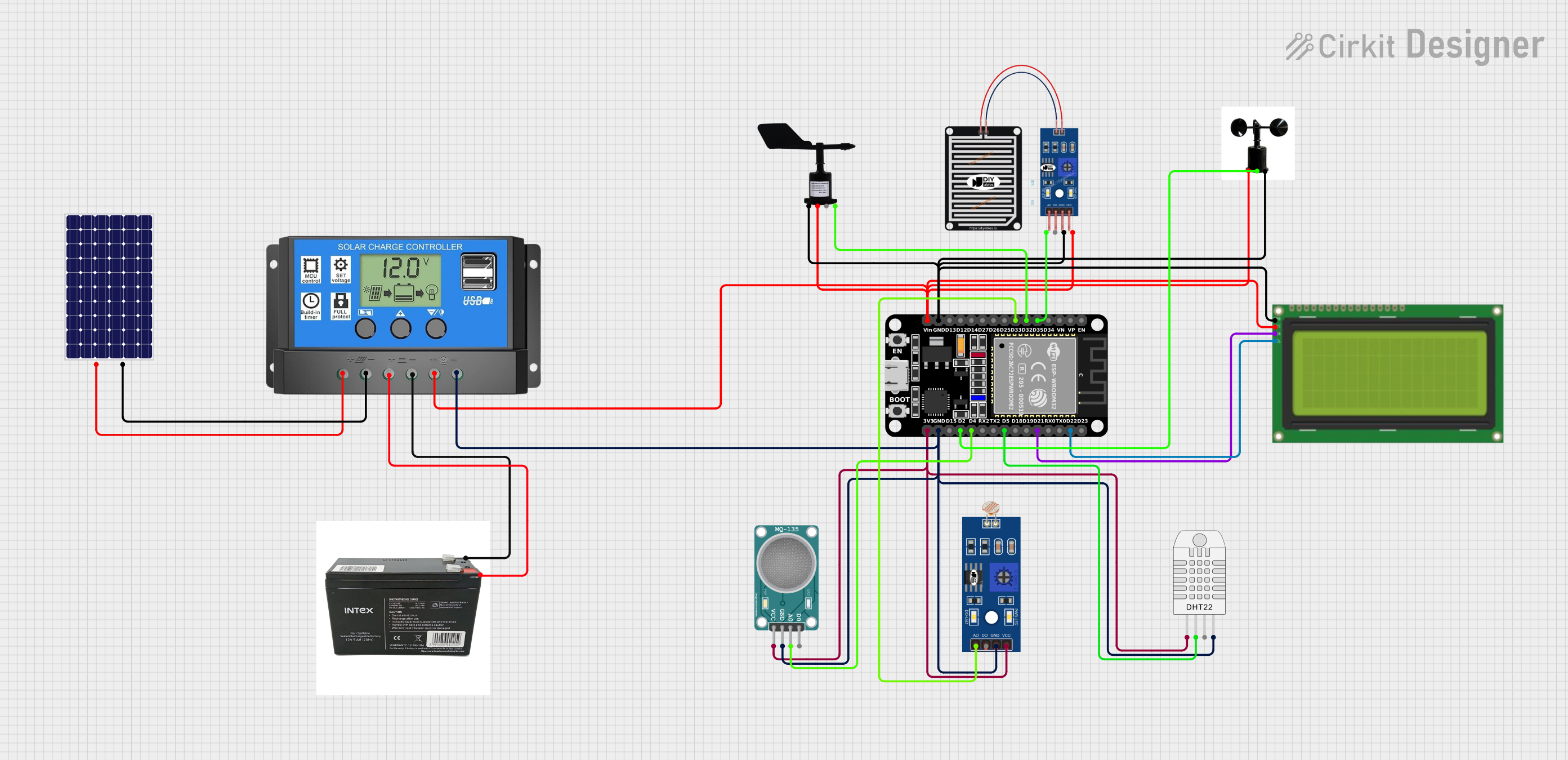
How to Use WIND TURBINE: Examples, Pinouts, and Specs

 Design with WIND TURBINE in Cirkit Designer
Design with WIND TURBINE in Cirkit DesignerIntroduction
A wind turbine is a device that converts kinetic energy from wind into mechanical energy, which can then be transformed into electrical energy. It typically consists of blades, a rotor, a generator, and a tower. Wind turbines are a cornerstone of renewable energy systems and are widely used to generate electricity in both small-scale and large-scale applications.
Explore Projects Built with WIND TURBINE

 Open Project in Cirkit Designer
Open Project in Cirkit Designer
 Open Project in Cirkit Designer
Open Project in Cirkit Designer
 Open Project in Cirkit Designer
Open Project in Cirkit Designer
 Open Project in Cirkit Designer
Open Project in Cirkit DesignerExplore Projects Built with WIND TURBINE

 Open Project in Cirkit Designer
Open Project in Cirkit Designer
 Open Project in Cirkit Designer
Open Project in Cirkit Designer
 Open Project in Cirkit Designer
Open Project in Cirkit Designer
 Open Project in Cirkit Designer
Open Project in Cirkit DesignerCommon Applications and Use Cases
- Renewable Energy Generation: Used in wind farms to produce electricity for residential, commercial, and industrial use.
- Off-Grid Power Systems: Provides power in remote areas where grid electricity is unavailable.
- Hybrid Energy Systems: Often combined with solar panels and batteries for a more reliable energy supply.
- Educational Projects: Used in schools and universities to teach principles of renewable energy and mechanical-to-electrical energy conversion.
Technical Specifications
Key Technical Details
| Parameter | Value/Range | Description |
|---|---|---|
| Rated Power Output | 100W to 10MW (varies by model) | Maximum electrical power output. |
| Operating Wind Speed | 3 m/s to 25 m/s | Wind speed range for optimal operation. |
| Cut-In Wind Speed | ~3 m/s | Minimum wind speed required to generate power. |
| Cut-Out Wind Speed | ~25 m/s | Maximum wind speed before shutdown for safety. |
| Rotor Diameter | 1m to 120m (varies by model) | Diameter of the rotating blades. |
| Tower Height | 10m to 150m (varies by model) | Height of the turbine tower. |
| Output Voltage | 12V, 24V, or 48V (small turbines) | Voltage output for small-scale turbines. |
| Generator Type | Permanent Magnet or Induction | Type of generator used to produce electricity. |
Pin Configuration and Descriptions
For small wind turbines with electrical connections, the pin configuration is as follows:
| Pin Number | Label | Description |
|---|---|---|
| 1 | Positive (+) | Positive terminal for DC output. |
| 2 | Negative (-) | Negative terminal for DC output. |
| 3 | Ground (GND) | Ground connection for safety and stability. |
| 4 | Brake | Optional pin to connect a braking system. |
Usage Instructions
How to Use the Component in a Circuit
- Positioning the Turbine: Install the wind turbine in an open area with minimal obstructions to ensure maximum wind exposure.
- Electrical Connections:
- Connect the Positive (+) and Negative (-) terminals to a charge controller to regulate the output voltage.
- From the charge controller, connect to a battery or inverter for energy storage or AC power conversion.
- Grounding: Ensure the Ground (GND) pin is properly connected to a grounding rod to protect the system from electrical surges.
- Braking System: If the turbine includes a Brake pin, connect it to a braking circuit to stop the turbine during maintenance or high wind speeds.
Important Considerations and Best Practices
- Wind Speed Monitoring: Use an anemometer to measure wind speed and ensure it falls within the turbine's operating range.
- Safety First: Always disconnect the turbine from the circuit before performing maintenance.
- Charge Controller: Use a compatible charge controller to prevent overcharging of batteries.
- Tower Stability: Secure the tower with guy wires or a strong foundation to prevent tipping in high winds.
- Regular Maintenance: Inspect the blades, rotor, and electrical connections periodically for wear and tear.
Arduino UNO Integration Example
For small wind turbines with a DC output, you can monitor the voltage using an Arduino UNO. Below is an example code to read the turbine's voltage:
// Wind Turbine Voltage Monitoring with Arduino UNO
// Connect the turbine's positive output to A0 and negative to GND.
const int turbinePin = A0; // Analog pin connected to turbine output
float voltage = 0.0; // Variable to store the measured voltage
void setup() {
Serial.begin(9600); // Initialize serial communication
pinMode(turbinePin, INPUT); // Set turbine pin as input
}
void loop() {
int sensorValue = analogRead(turbinePin); // Read analog value from turbine
voltage = sensorValue * (5.0 / 1023.0); // Convert to voltage (5V reference)
// Print the voltage to the Serial Monitor
Serial.print("Turbine Voltage: ");
Serial.print(voltage);
Serial.println(" V");
delay(1000); // Wait 1 second before next reading
}
Troubleshooting and FAQs
Common Issues and Solutions
- No Power Output:
- Cause: Insufficient wind speed.
- Solution: Relocate the turbine to a windier location or wait for higher wind speeds.
- Overheating:
- Cause: Prolonged operation at high wind speeds.
- Solution: Install a braking system or automatic shutdown mechanism.
- Irregular Voltage Output:
- Cause: Faulty connections or damaged generator.
- Solution: Check all electrical connections and inspect the generator for damage.
- Turbine Not Spinning:
- Cause: Mechanical obstruction or low wind speed.
- Solution: Remove any obstructions and ensure the blades are free to rotate.
FAQs
Q: Can I use a wind turbine in low-wind areas?
- A: Yes, but you may need a turbine designed for low wind speeds or consider hybrid systems with solar panels.
Q: How do I protect the turbine during storms?
- A: Use a braking system or manually shut down the turbine to prevent damage.
Q: Can I connect the turbine directly to an inverter?
- A: No, always use a charge controller to regulate the output before connecting to an inverter.
Q: How often should I perform maintenance?
- A: Inspect the turbine every 6 months or after severe weather conditions.